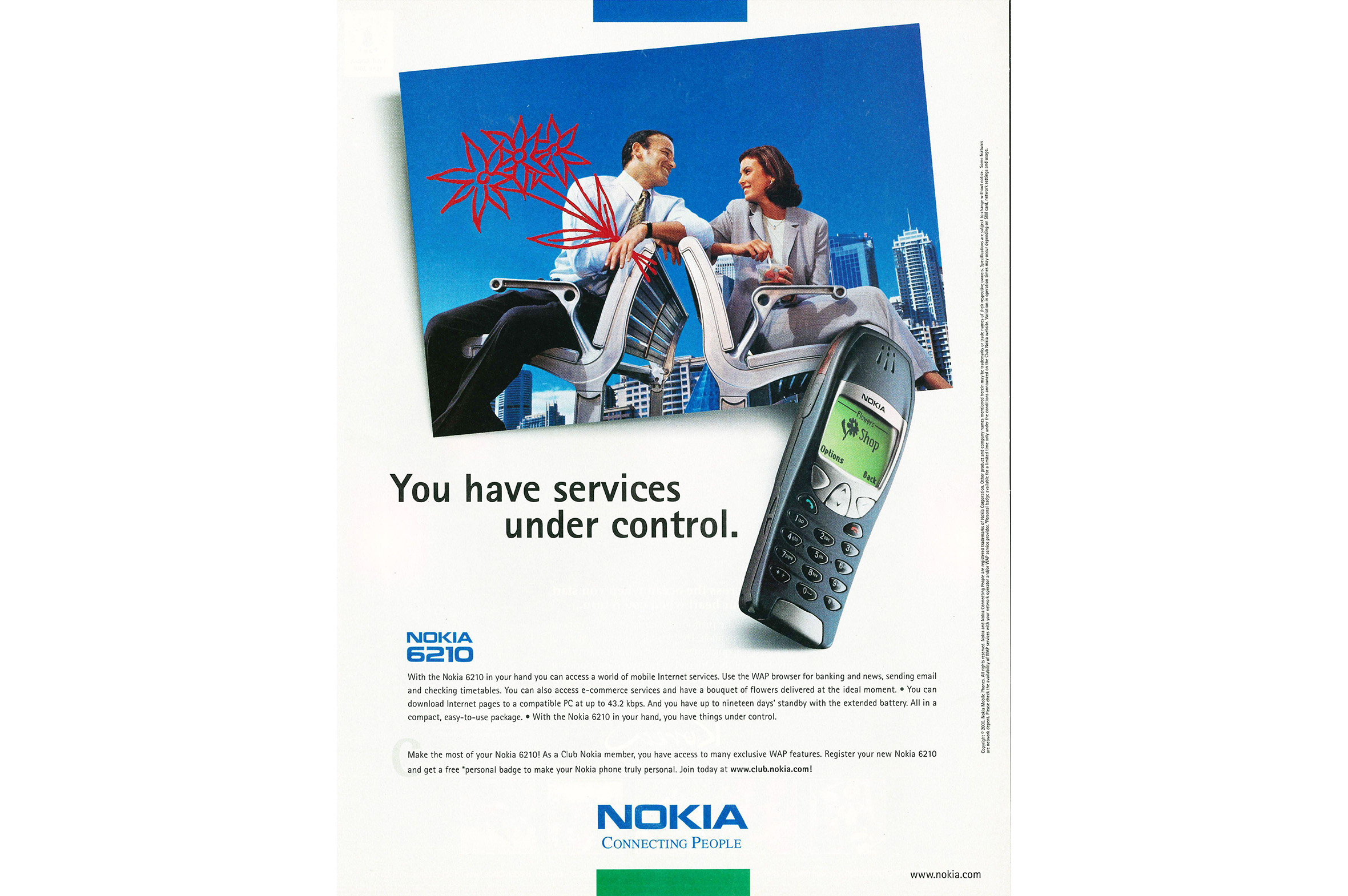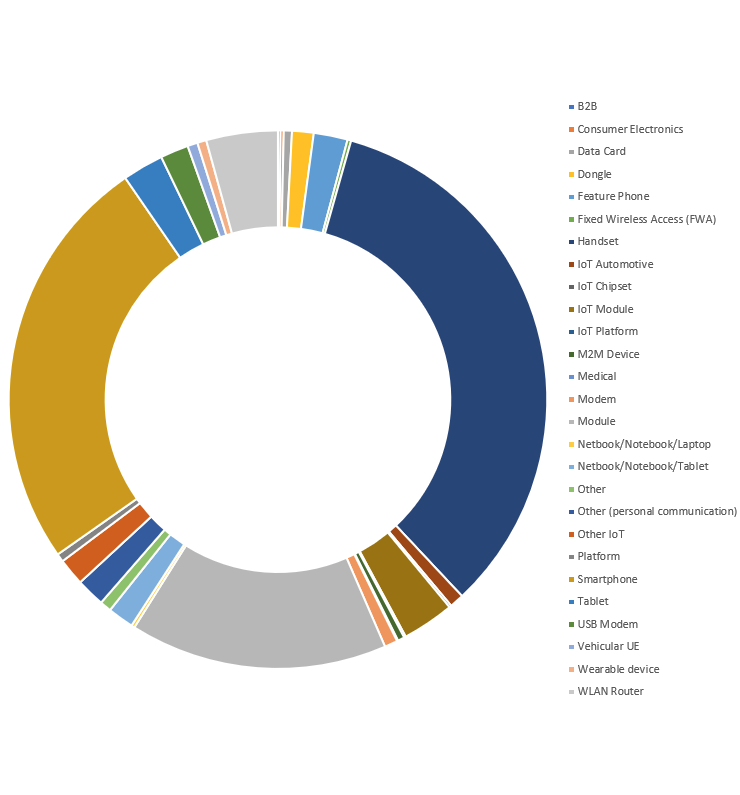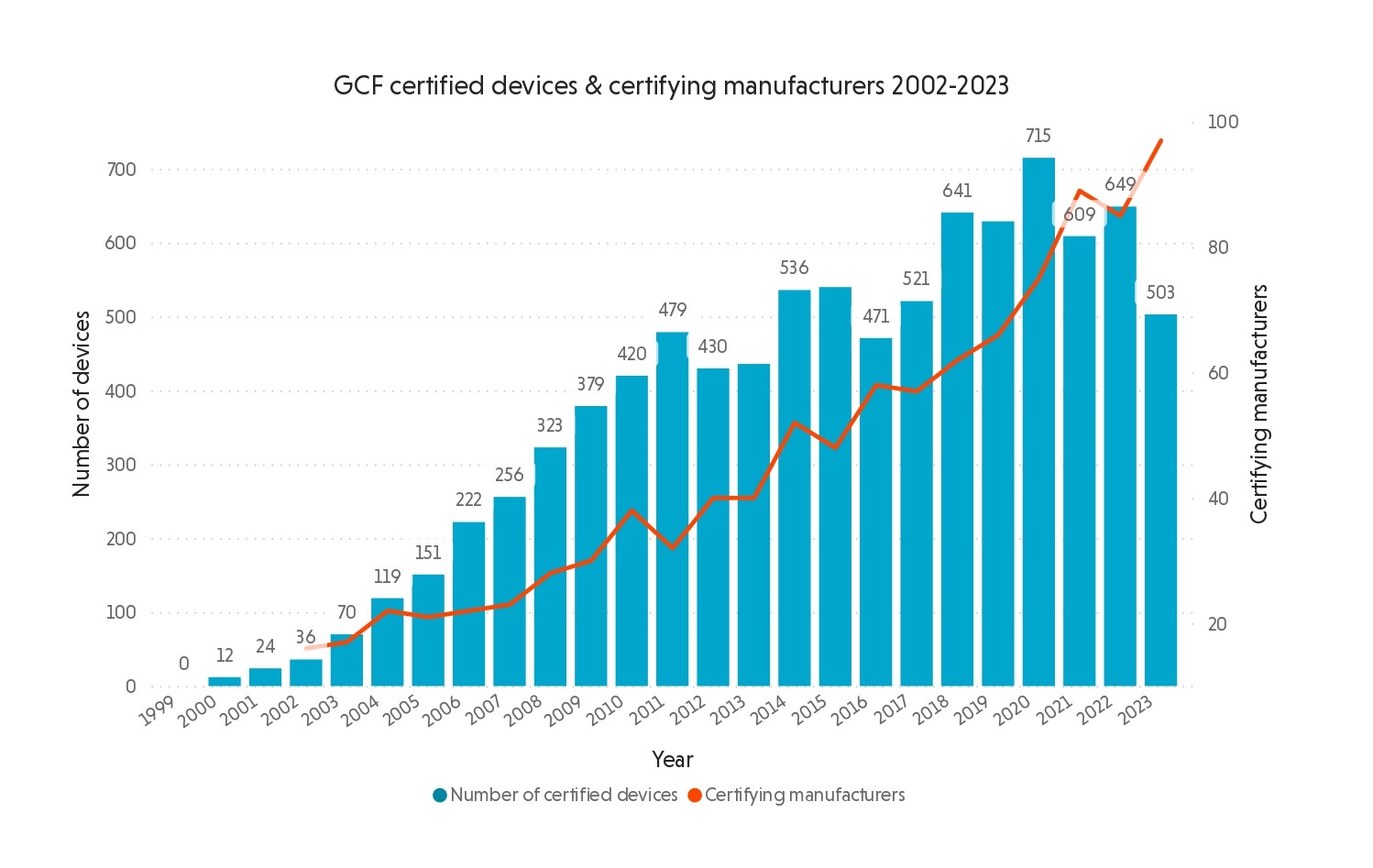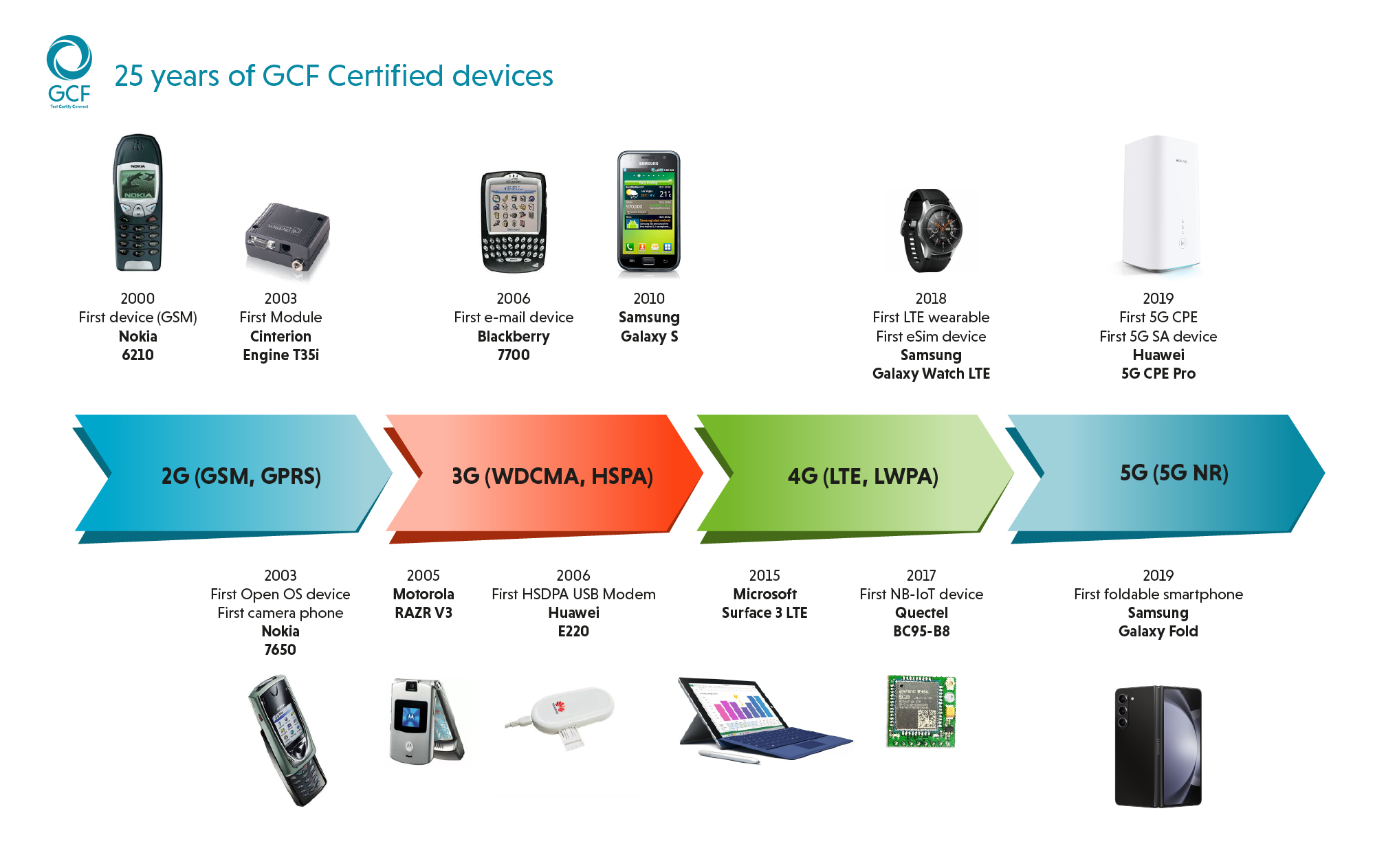25 years of GCF - Helping the telecom industry to connect mobile devices and networks seamlessly since 1999
- 15 Apr 2024
- Lars Nielsen
The past is a foreign country; they do things differently there. But in technology, the past can feel so different that it’s a whole new planet. Let’s look back 25 years, to 1999: we were dealing with the Millennium Bug, while navigating the World Wide Web via dial-up. There were no smartphones yet, of course, but the mobile communications industry in 1999 was already a global juggernaut, with hundreds of millions of subscribers and a rapid rate of growth. The launch of 3G was coming up fast, and the mobile internet was poised to take over our lives.
In 1995, the European Community (EC) announced a change in telecom regulation with the R&TTE Directive, which removed requirements for interworking with networks (Type Approval), and was scheduled to come into effect in 1999. For the mobile industry leaders at the time, it was clear there would come a need for strong, well-managed certification of devices, to ensure problem-free interworking, as it was called then, or interoperability, as we would say today.
Following this announced regulatory change, the CTF (Certification Task Force) was started by industry operators in 1997 and joined by leading manufacturers. The CTF then evolved into the Voluntary Certification Scheme (VCS) that held meetings over a period of several months, leading to the “London Agreement” on 24th August 1999 by nine manufacturers, ten operators, and the GSM Association.
At this meeting in London, the principles of the Global Certification Forum were defined and agreed, being a key principle that decisions would require dual majority of both participating operators and device manufacturers. The Global Certification Forum was being effectively set up, where all operator members being part of the GSM Association (GSMA), device manufacturers, and other parties with an interest (observers) could participate in the certification activities. The rest, as they say, is history.
Milestones of GCF
Since the foundation of GCF, its certification programs have been helping the industry to deploy new mobile standards-based technologies, in all standards-based wireless communication generations from GSM to 5G. Through the years, GCF’s activities and certifications have evolved in line with the technology developments. As a result, tracking GCF’s milestones gives us an insight into the progress of our industry. The first device certified by GCF was the Nokia 6210, a GSM single band handset, back in the year 2000. Within the same year, the first dual-band GSM handset (Motorola V51) and the first handset supporting GPRS, Motorola T260, were also certified by GCF. The jump from circuit-switched to packet-switched with GPRS was an important step for the industry.

Image 1: First device certified by GCF, Nokia 6210
Image credits: Nokia
The third generation of wireless communication standards arrived, with the first 3G device certified by GCF being a modem from Novatel Wireless (Merlin U630) in 2004, followed by the first 3G handset supporting videotelephony (Motorola RAZR V3X) and the first handset certifying a 3GPP UTRA band from Panasonic (VS70), in 2005 and 2006, respectively.
Similarly, we saw GCF certify its first 4G data device, a USB modem by Samsung, in 2011, and the first smartphone in 2012 (HTC One). The addition of CDMA technology, in 2014, continued the activity started by CCF (CDMA Certification Forum). Huawei was the first company to certify 5G devices, a home router (Huawei 5G CPE Pro) and a smartphone (Huawei Mate 20x 5G) in 2019. Looking beyond handsets and personal data devices, GCF certified its first M2M-oriented device, a GPRS module and a serial modem from Siemens Cinterion Wireless Modules, in 2003, and the first 3G module in 2004, from Belgian company Option.
Since the first device was certified in the year 2000, GCF has established itself as the quality mark for all types of cellular wireless communication devices, with more than 9000 devices from 245 manufacturers certified. Handsets, smartphones, modules, and WLAN routers have been the categories with the most devices certified.

Figure 1: Categories of GCF-certified devices, 2000 - March 2024
The administrative aspects of GCF were initially handled within GSMA. In 2008 GCF became fully independent with the incorporation as a UK company with 160 active members, including 37 full members, 40 observers and more than 80 associate operators.
The GCF members portal was set up since the beginning of GCF activities to cover the needs of the organisation, its membership and cooperating partners as well as host the database of certified devices.
Field trials were included some years later based on the GSMA TSG TS.11 specification, becoming mandatory for LTE devices in 2010. Performance items were included in 2011, covering areas relevant, but not mandatory, in the GCF certification, such as acoustics, battery life and antenna performance.
The setup of the DCC (Device Conformance Criteria) tool to facilitate tracking the status of work items, test platforms and test case validations to all industries was done in 2007, evolving from a more manual process. GCF moved in 2021 to a new, evolved version to keep up with the growing complexity in the certification criteria due to the evolution of LTE and 5G. Today the DCC is the most comprehensive database with test information for devices implementing 3GPP standards.

Figure 2: GCF certified devices & certifying manufacturers 2002-2023
Co-operation and industry presence
Co-operation has been a vital part of our work through the years. GCF has started work streams with TCCA on standards-based Mission Critical Communication, as well as with 5GAA in Connected Vehicle. This has led to the development of specific certification programs in these areas.
Currently GCF partners with 19 organisations and is actively working on NTN (non-terrestrial networks, or satellite) with GSOA, Mission Critical with TCCA, and Connected Vehicle with 5GAA. We are also actively working on certifications for the IoT, with established partnerships with 450 Alliance, TTA, 5G-ACIA and close collaboration with EUTC focused on industrial IoT, private networks and cellular standards for utilities.
Since 2015, IoT has become a key part of GCF activity: in the year 2023 the number of wireless modules, for IoT and mobile broadband use cases, surpassed consumer-oriented mobile phones (mainly smartphones) for the first time. Throughout the years, GCF has participated in key telecom industry trade shows and conferences, including MWC Barcelona, MWC Americas, MWC Shanghai, India Mobile Congress, Critical Communications World, IoT Solutions World Congress, and Embedded World Congress & Conferences. GCF has also participated in more regionally focused events in South Africa, Brazil, GSMA 360 LATAM, GSMA 360 Middle East, and China.

Figure 3: 25 years of GCF Certified devices
Image credits: Blackberry, Cinterion, Huawei, Quectel, Microsoft, Motorola, Nokia, Samsung, Siemens
GCF by the numbers
Some key numbers:
- 736 companies have participated in GCF, and thousands of delegates have participated in more than 750 meetings in 28 countries from 5 continents.
- Today, over 1600 people have an active account in GCF, while more than 3700 people have had an active account in GCF at some point in time.
- More than 350 companies are now part of GCF, including 99 of the companies that were active in 2008 when it was incorporated as a UK company, while more than 250 additional organisations have joined GCF in the last 16 years.
- Of the companies that are no longer members of GCF, some have ceased operations, but most have changed their legal names or merged with other industry players and remain engaged with the organisation.
- GCF is today a key stakeholder in the mobile world, with strong and close cooperation with GSMA requirements, ETSI and 3GPP standards. GCF became a 3GPP Market Representation Partner in 2016.
- Currently, the number of GCF members has grown to 170 manufacturers, 127 operators, and 55 observer companies, mostly representing the test industry.
- GCF now has 67 conformance testing laboratories, known as recognised test organisations (RTOs), in 11 countries, and 39 field trials laboratories (field trial RTOs) in 10 countries.
- The number of Work Items (areas that can be certified individually, linked or not to specific frequency bands) has grown above 1,300 over the years, with over 88,000 test cases validated, over 55,000 validations of test cases and specific frequency band combinations and over 130 active test platforms from 14 different test equipment vendors covering all different technologies.
Impact on the mobile industry
If we can blow our own trumpet for a moment: GCF has had an immense impact on the mobile industry. As the numbers above show, we have ensured global participation, with strong growth in the number of manufacturers participating, and expansion into multiple verticals such as IoT and mission critical services.
Today, all modems and SoCs are designed to meet GCF requirements. We have maintained strong alignment with 3GPP in RAN technologies over different generations, which has facilitated the reduction of fragmentation in the industry. Overall, mobile communications defined and standardised by 3GPP and subsequent certified by GCF have proven to be a trusted, successful story for the mobile industry. The bottom line: billions of consumers and IoT connections rely on and benefit from GCF-certified devices.
Looking ahead: the next 25 years
As technology matures, the clear focus goes on the introduction of new technologies, such as newer 5G features, additional frequency bands and non-terrestrial standards-based wireless communication. In parallel, GCF adapts to the sunset of older generations of Radio Access Technologies, such as 3G/WCDMA and 2G/GSM.
GCF has constantly adapted over time and will continue to do so in the future. We follow ever-changing markets, thanks to the contributions of our members, and the availability of the standards in SDOs. As the 6th generation of Mobile Communications (6G) is being defined, GCF is well prepared to deliver certification programs for the upcoming generations of mobile technology, as it has been doing since it started with 2G.
We are immensely grateful for the contributions and support over the years from our stakeholders: Members, board of directors, GCF Office, partners, and everyone else in the industry with whom we have had the privilege of working.
For more information, please refer to the booklet "A Foundation for the Future: 25 years of GCF", available for download here.

